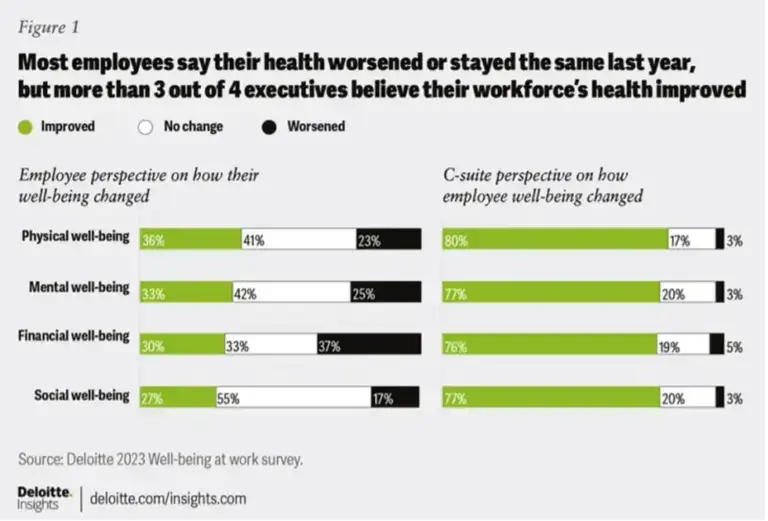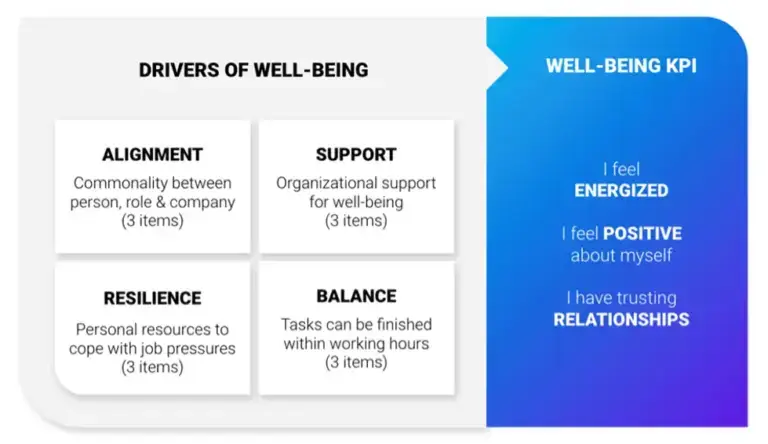In this article, we’ll take a close look at some of the key drivers of employee wellbeing, the benefits of supporting wellbeing at work, what has impacted employee wellbeing, and some things to consider when designing a wellbeing program. Plus, how to keep improving employee wellbeing at your organization.
Employee wellbeing filters into every aspect of an organization: engagement, attraction and retention, sickness absence, performance, productivity, and ultimately revenue. And when employee wellbeing suffers, so does the health of your business.
And by employee wellbeing, we don’t just mean wellbeing at work. We mean wellbeing at home too, as there’s an intricate connection between our home life and our work life. Who hasn’t had a spoiled evening at home because of something that went wrong at work that day? And who can fully concentrate at work when there are problems at home?
As an employer, it’s in your interests to ensure that your people can be their best selves both at home and at work, and that requires a nuanced understanding of what drives wellbeing. It needs to be woven into your organization’s DNA, culture, leadership and team management, especially when we’re growing into a talent shortage.
Free eBook: Designing a world-class EX program that attracts and retains talent
What is employee wellbeing?
The term ‘employee wellbeing’ covers all aspects of working life: health and safety, the physical working environment, the company culture, work-life balance, employees’ physical and mental health, financial wellbeing, and employees’ job satisfaction. Work environments that foster employee wellbeing deliver positive outcomes for individuals and the organization.
Employees who report positive well being enjoy positive emotional states and consider themselves more engaged, productive, and more able to face challenges.
Gallup discovered ‘five universal elements of wellbeing’:

Image from gallup.com
It doesn’t take too much imagination to make the holistic connections between wellbeing at work and wellbeing at home:
- Career: You have a great employee experience and enjoy your job.
- Social: Some of your friends may be work colleagues.
- Community: You may live within traveling distance of your work, or if working remotely, be able to live somewhere you want to.
- Physical: Work life and home life energize rather than drain you, mentally and physically.
- Financial: You’re paid fairly and can manage your money and finances.
The benefits of workplace wellbeing
If an employee isn’t feeling their best, physically or mentally, they can’t do their best work. Therefore, it’s critical to take employee wellness seriously – by investing in wellbeing and employee mental health resources – to support employees so they can be productive for your business.
And wellbeing initiatives can’t come fast enough. Research by Deloitte found:

This clearly shows the disconnect between leadership perception of employee wellbeing, and that of the employees themselves.
The same research finds that:
- 60% of employees
- 64% of managers
- 75% of the C-suite
are seriously considering quitting for jobs that are more supportive of wellbeing. These are big numbers.
Here are some of the benefits of supporting employee wellbeing:
Candidate attraction and employee retention
We’re going into a talent shortage right now, according to the World Economic Forum. By 2025, it’s estimated that:
- 85 million jobs will disappear
- 97 million new jobs will be created
- 50% of the global workforce will have to reskill.
You’ll need to attract – and retain – the very best people you can. By prioritizing wellbeing, you’ll make your employee experience more human. And when organizations do this, talent starts to gravitate towards them, talk about how their employer handles work life balance, benefits, healthcare, physical and mental health support – and become staunch advocates.
Enhanced employer reputation
These staunch advocates will help your business and brand get a reputation as a great place to work, and more talented people will want to come and work for you. The American Psychological Association reports that 89% of employees will recommend their company as a good place to work if the company supports wellbeing initiatives.
Reduced absenteeism and healthcare expenses
Wellness programs improve employee health and morale – two factors that decrease absenteeism. One meta-analysis of 42 studies found that participants in workplace health promotion programs had around 25% lower medical and absenteeism expenditures than non-participants.
According to a 2010 Harvard Wellness Program Meta Study, for every dollar that’s spent on an employee wellbeing program, a company saves $3.27 because of reduced healthcare costs.
Less burnout
On the other hand, if you don’t invest in employee wellbeing, you risk employees burning out, not being as productive as they can, and increased safety risks. These risks include accidents at work, which can have detrimental emotional, physical, financial, and legal implications.
Improved employee engagement
There’s a strong link between employee engagement and employee well being. Isolated, stressed workers become demotivated or burnt out, and disengage from their work, whereas engaged employees are less at risk of burnout and are more productive.
Our 2023 EX Trends Report found that of employees who feel that they have a good work-life balance, almost two-thirds (63%) are willing to go above and beyond for their organization – something that only engaged employees will do.
Heightened feelings of empowerment
Employees who say their company makes a proactive effort to support mental health are 61% more likely to feel that their company is communicating to them the information they need to look out for their own health and wellbeing.
What has impacted employee wellbeing?
The pivot to remote and hybrid work
Although the pandemic that triggered so many changes began more than three years ago, its aftershocks are still rumbling beneath the world of work. Organizations, and employees are still trying to work out the best ways of working – fully remote, hybrid, or fully at work.
The pandemic blurred many of our built-in boundaries with work, and knocked work-life balance off-kilter. Especially for those working from home for the first time, remote working and hybrid work meant more time sitting in front of a laptop – and not knowing how or when to switch off.
Poor processes and inefficient systems
Our 2023 EX Trends Report found that over a third (38%) of employees feel they’re burnt out, and the top driver of burnout is ineffective processes and systems.
These past few years have completely disrupted how organizations do things — from how they hire and the tools they use, to what processes are in place to get work done.
These disruptions have changed how employees perceive their productivity — and organizations may be taking too long to resolve them.
Being a parent and/or caregiver
Having to play multiple roles at the same time – that is, working from home while also being a parent and/or caregiver – has been extremely difficult for many employees. A study we conducted revealed some unfair treatment, in that 45% of working parents felt discriminated against in the workplace as a result of focusing on family responsibilities during the pandemic.
Uncertainty around job security
Post-pandemic, workers in some industries feel more secure than others to look for new jobs (hence, The Great Resignation). For others, the pandemic accelerated plans for automation in their industries, causing workers’ concerns about artificial intelligence (AI), job security and longevity.
The geopolitical situation: the Ukraine/Russia conflict, instability in the Middle East, the global economic slowdown, continued supply chain challenges, and the climate crisis are all concerns that cause people to worry that the ramifications of these might impact their jobs in the near term.
Measuring employee wellbeing
It’s essential that you measure wellbeing, and meet employees where they are. Their concerns – and what’s important to them – will change over time. Listening tools such as quarterly surveys, frequent pulse surveys and continuous listening allow leaders to tune in to those evolving needs and then act on that feedback accordingly.
This goes way beyond guessing at the needs of employees – and who we think has those needs – by being more intentional with actions and supporting employee wellbeing in real-time.
Our Employee engagement solution reveals how energized employees feel, how positive they feel about themselves, and what level of trusting relationships they have at work. These key performance indicators (KPIs) are scientifically proven to illustrate employees’ evolving state of well-being, and are driven by understanding the following drivers:
- Alignment: Job fit between the individual and role
- Support: Organizational-level support for employee well being
- Resilience: Personal resources to cope with job pressures
- Balance: Tasks can be completed within working hours

The solution distributes insights and suggested actions to individual employees and managers based on responses. Employees receive personal reports, giving them an understanding of their own well-being and what to focus on to feel more energized at work. Managers access intuitive dashboards that summarize how their team is doing and enable them to crowdsource ideas from their team members to help improve team-wide well-being.
Steps for improving employee wellbeing at your organization
Now that we’ve looked at the benefits of, and components for designing an employee wellbeing program, it’s time to take action.
Here are seven steps to help you improve employee wellbeing at your organization.
Step 1. Clarify your return to office (RTO) policy
Like many other organizations, you’re probably still sorting out the best approach to your return to office (RTO) policies. You’ll need to balance the needs of:
- new employees, for whom a fully remote work arrangement limits their interaction with colleagues and supervisors, and may lead to a sense of detachment from the team
- established employees who don’t want to fully immerse themselves in remote work, wanting perhaps to socialize with others in person, draw stricter boundaries between work and home, or simply get dressed and out of the house every day.
- individuals who thrive in remote work environments and find that it improves their wellbeing.
Our 2024 EX Trends report found that those employees who work in the office 1-3 days a week report higher levels of inclusion and well-being (+12 points each) than those who work fully remote or five days in the office:
EX KPI scores lowest when employees work in the office every day
| KPI | 0 days in the office | 3 days in the office | 5 days in the office |
|---|---|---|---|
| Engagement | 71% | 77% | 60% |
| Intent to stay | 65% | 68% | 63% |
| Inclusion | 75% | 80% | 67% |
| Well-being | 73% | 79% | 66% |
Perhaps our findings will help inform your RTO policies to make your employee wellbeing the best it can be.
Step 2. Support your managers
Managers are ‘piggy in the middle’ between their employees and senior leadership, and the demands coming up and down on them can lead to burnout themselves. After all, we saw above that 64% of managers would consider leaving an organization for one that supports wellbeing better.
You can support your managers in these three ways:
1. Encourage them to lead with empathy
In addition to workload, managers being more supportive, leading with empathy, and generally understanding and knowing what’s going on in each employee’s work life, go a long way to support employee wellbeing.
For those working parents and caregivers juggling responsibilities and remote work, having positive relationships with managers who are:
- aware of their situation at home
- flexible and empathetic
- enabling employees to get work done
will help them feel seen and supported. The manager (and organization) that appreciates the value employees bring is a useful facilitator in ensuring employee wellness. Poor management, on the other hand, leads to disengagement and poor wellbeing.
2. Helping them understand where to drive change
Managers can be untrained, underprepared, and burned out. A recent Qualtrics study found that 43% of managers feel more pressure to produce results than they did a year ago. It’s essential that managers understand how their teams are feeling, and the experience their employees are having, and are then empowered to do the right things to keep their teams working efficiently and effectively, while also avoiding costly employee attrition.
Managers need the right tools to be able to measure how their teams are feeling so they can step in before things become problematic, and put in interventions that help their teams thrive instead.
Our Manager Assist analyzes the feedback employees give through engagement surveys, and, with People Analytics, what employees are saying on public channels. In a single place, managers can listen, understand and act on feedback from their own teams, in real time, to keep employees engaged and productive.
3. Encourage them to be role models
There’s no point in a manager encouraging their teams to look after their wellbeing when they themselves stay at their desks for long hours and rarely take all their PTO. Managers who are good role models will inspire, motivate and guide their teams to achieve their goals, look after their wellbeing, and grow professionally.
A good manager models the behaviors, attitudes and values that they expect from their team members. They’re honest, ethical and accountable, demonstrating commitment, passion and enthusiasm for the team’s work.
Step 3. Offer job security
Just now, more than anything, your people want to know that the organization they’re working for will carry on being successful in the future, and will pay them a competitive salary. Job security and financial certainty are at the top of employees’ priority lists.
Our 2023 EX Trends Report found that only just over half of employees (57%) are happy with their current pay and benefits, down 10 points on last year. And for frontline workers, the lifeblood of your organization, only 50% feel they are rewarded satisfactorily, according to our latest 2024 EX Trends report. Financial stress is not conducive to employee wellbeing, so ensure you pay your people properly and be honest and transparent with them about your organization’s health.
Step 4. Develop your employees
Nobody thrives in a dead-end job with no prospects of training and development. Boredom, frustration, exhaustion and feelings of hopelessness are terrible for occupational health. Employees who are given opportunities to train and develop feel more valued, respected and appreciated by their employers, which in turn boosts morale, confidence, engagement with their work – and wellbeing.
Step 5. Empower all your people with the right tech
As we’ve mentioned above, employees are being burned out because of inefficient systems and bad processes. There’s really no excuse today not to give your employees – in every department – the right tools to get their jobs done, collaborate, communicate, and manage their work life balance for optimum well being:
- For your managers: continuous listening can help managers create the best employee experience, and thus support well being. Features such as 360 feedback and pulse surveys help identify issues early so they can be rapidly resolved.
- For your HR teams, candidate experience, people analytics and employee analytics will help them understand what your workforce needs (even before they’ve joined the organization).
- For your CX and contact center teams, working at the frontline of your business, continuous listening and AI help streamline processes to meet ever-changing customer expectations.
- For your market researchers, use built-in AI to help conduct smarter, faster research by bringing quantitative and qualitative techniques and analysis together to humanize data – and your business strategy.
Step 6. Help employees manage their workloads
As mentioned above, an employee’s workload has a lot to do with their wellbeing. And our research suggests that there’s a sweet spot for employee workload – not too much work to be overwhelmed, but also not too little to be unchallenged and bored.
Open and regular communication between employees and managers can keep workloads at manageable levels, help people prioritize their tasks, achieve better work-life balance, and alert leaders when an employee might start to feel overwhelmed.
Step 7. Provide more workplace mental health services as a benefit
From covering mental health-related expenses to additional EAP resources, and even setting up a dedicated wellbeing team, providing employees with free and easily accessible mental health resources will help to better support their overall well being.
Learn more about how to improve employee wellbeing
And finally…
Employee wellbeing needs to be a core metric of your employee engagement model as disruption continues into 2024. Employees cannot thrive or do their best work in a toxic working environment, so active listening and recognizing their contributions is essential for employee happiness.
Pulse surveys were, and remain, the most effective way to ‘take the temperature’ of employee concerns. Appetite for this agile employee listening method has, if anything, increased as leaders appreciate the amount of information that can be gathered and analyzed with pulse surveys.
And when you combine your operational (O) data with your experience (X) data on a platform such as Qualtrics® People Engage you’ll be able to gather continuous employee feedback from every experience. With these insights, you’ll be able to take the right actions to enhance employee wellbeing, employee engagement, human resources, productivity, and planning, and put your valuable people first.
Free eBook: Designing a world-class EX program that attracts and retains talent